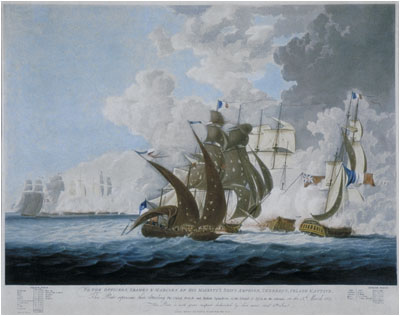Frederick Devoe was born in 1787/88 in Italy. He first shipped when he was 21 years old and would serve two years in the Italian Navy during the Napoleonic wars. For the next 28 years, he would serve in the U.S. Navy and onboard U.S. merchant ships.

British Ships Amphion, Cerebus, Volage and Active attacking the French and Italian Squadrons off the Island of Lissa in the Adriatic, March 13, 1811
Frederick Devoe had a wife, Eliza, and a son that resided in Brooklyn, New York. He would enter sailors Snug Harbor on April 30, 1871, and remain at the Harbor for 11 years, four months, and 19 days, dying on January 16, 1883, at 96 years old. He is buried in Saint Peters Cemetery in Long Island, NY.
The USS Ship Franklin, with a View of the Bay of New York, Artist Thomas Thomston, 1820s/1830s, oil on Canvas.
Metropolitan Museum of Art, New York, URI: https://www.metmuseum.org/art/collection/search/12806 .
Frederick Devoe served on the USS Franklin, a ship-of-the-line built in 1815 under the supervision of Samuel Humphreys. On October 1817, the USS Franklin sailed on her first cruise under the Command of Master Commandant Henry E Ballard and bearing the broad pendants of Commodore Charles Stewart. Frederick Devoe was one of the Seamen on the Franklin that would see Richard Rush, Minister of England, to his post and then do service in the Mediterranean, where the USS Franklin would be designated the Flagship of the Mediterranean Squadron (Naval History and Heritage Command). The Mediterranean Squadron concentrated on protecting shipping from from the Barbary Pirates. The USS Franklin returned to New York on April 24, 1820 (Naval History and Heritage Command).
After his service in the US Navy, Frederick Devoe would spend 25 years in the merchant trade and would be known as Captain Devoe at Sailors Snug Harbor (North, 198).